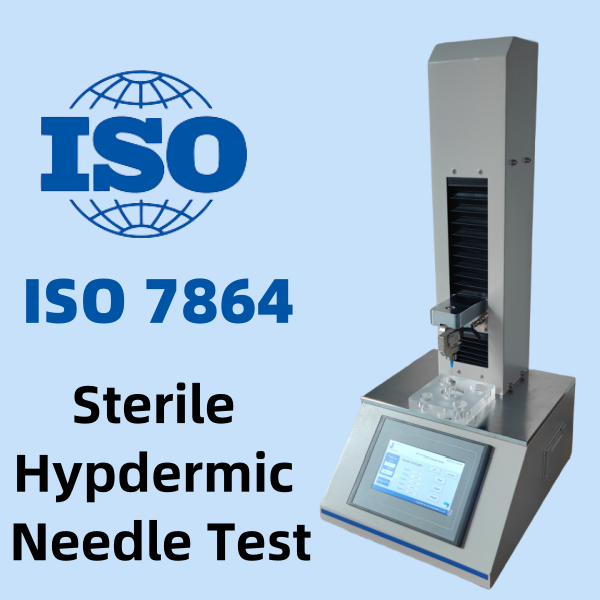ISO 7864
Sterile Hypodermic Needle Test
Sterile hypodermic needles are vital components in medical and pharmaceutical procedures, requiring high levels of safety, reliability, and performance. To ensure compliance and functionality, ISO 7864 sets forth stringent requirements and test methods. These include the needle penetration test, test prebojne sile, in needle bonding strength test, all critical for verifying needle quality.
ISO 7864 for Sterile Hypodermic Needle Test
ISO 7864, titled “Sterile hypodermic needles for single use — Requirements and test methods”, defines key mechanical and performance criteria for hypodermic needles. The standard ensures that each needle demonstrates sufficient sharpness, structural integrity, and reliable bonding between the needle tube and hub. It also prescribes detailed procedures for both penetration force testing in bond strength testing, which are essential quality metrics in sterile needle manufacturing.
Needle Penetration Force Test
The needle penetration test measures how much force is required to insert a needle into a specified substrate at a consistent rate. According to ISO 7864 Dodatek D:
- A force measurement apparatus (e.g., a load cell-based tester) is used.
- The test speed is typically 100 mm/min.
- Needles must penetrate up to 80% of their nominal length.
- Substrates like natural latex rubber or polyurethane simulate human skin.
Two critical parameters are captured:
- Peak Penetration Force: The maximum force required for the needle to pierce the substrate.
- Drag Force: The average frictional resistance during the insertion.
Cell Instruments ponuja a precision penetration force tester, ideal for conducting the needle penetration test. Its high-resolution sensors and programmable speed control ensure full compliance with ISO 7864.
Needle Bonding Strength Test
-Between Needle Tube and Hub
Priloga E of ISO 7864 focuses on the needle bonding strength test, which ensures that the bond between the needle tube and hub can withstand mechanical stress without detaching.
The procedure includes:
- Mounting the needle vertically in a universal tensile tester.
- Using specialized grips to avoid slippage or deformation.
- Applying tensile force at 50 mm/min until the bond fails.
- Recording the maximum tensile force at which failure occurs.
This test validates the mechanical integrity of the needle bonding system, a key requirement to prevent medical mishaps during injections or fluid transfer.
The Cell Instruments Bond Strength Tester supports ISO 7864-compliant tensile tests with customizable fixtures for different needle types.
Aplikacije v panogah
The ISO 7864 needle test methods aren’t limited to just medical syringe manufacturers. They also apply to:
- Pharmaceutical companies developing injection-based drug delivery systems.
- Packaging manufacturers producing prefilled syringe kits.
- Quality inspection agencies conducting regulatory testing.
- R&D labs studying material compatibility and performance.
Cell Instruments’ equipment is used globally in medical, pharmaceutical, adhesives, packaging, in quality control sectors, reinforcing our reputation for technical excellence.
Choosing the Right Test Equipment for ISO 7864
Testing accuracy hinges on using the correct instruments. When selecting oprema za testiranje penetracije igle or a bond strength tester, consider the following:
- Load Cell Accuracy: Ensure it aligns with the required force range (up to 500 N for bonding tests).
- Speed Control: ISO 7864 mandates exact speeds (e.g., 50 mm/min, 100 mm/min).
- Substrate Handling: The substrate holder should provide consistent clamping and penetration area.
- Integracija programske opreme: Data collection and analysis features enhance testing transparency and reproducibility.
Celični instrumenti specializes in tailor-made testing systems for medical devices, including sterile hypodermic needles. Our automation and customization services allow you to align with ISO 7864 precisely and efficiently.
Pogosto zastavljena vprašanja
The needle penetration test measures the force needed for a hypodermic needle to pierce a standard substrate, simulating skin penetration to assess sharpness and ease of use.
ISO 7864 specifies minimum bonding force requirements between the needle tube and hub based on needle size. The test ensures that the connection won’t fail during use.
Common substrates include natural latex rubber, polyurethane, silicone rubber, or polyethylene films, all validated for test consistency.
Reusing substrate sites can affect test accuracy due to deformation or wear, leading to unreliable force measurements.
Contact Us Get ISO 7864 Testing Solution
Compliance with ISO 7864 is non-negotiable for any manufacturer of sterile hypodermic needles. Understanding the needle penetration test, test prebojne sile, in needle bonding strength test ensures that needles meet required safety and performance standards. With advanced, standards-aligned equipment from Celični instrumenti, testing becomes more precise, reliable, and efficient—helping you deliver products that meet both regulatory and patient expectations.


